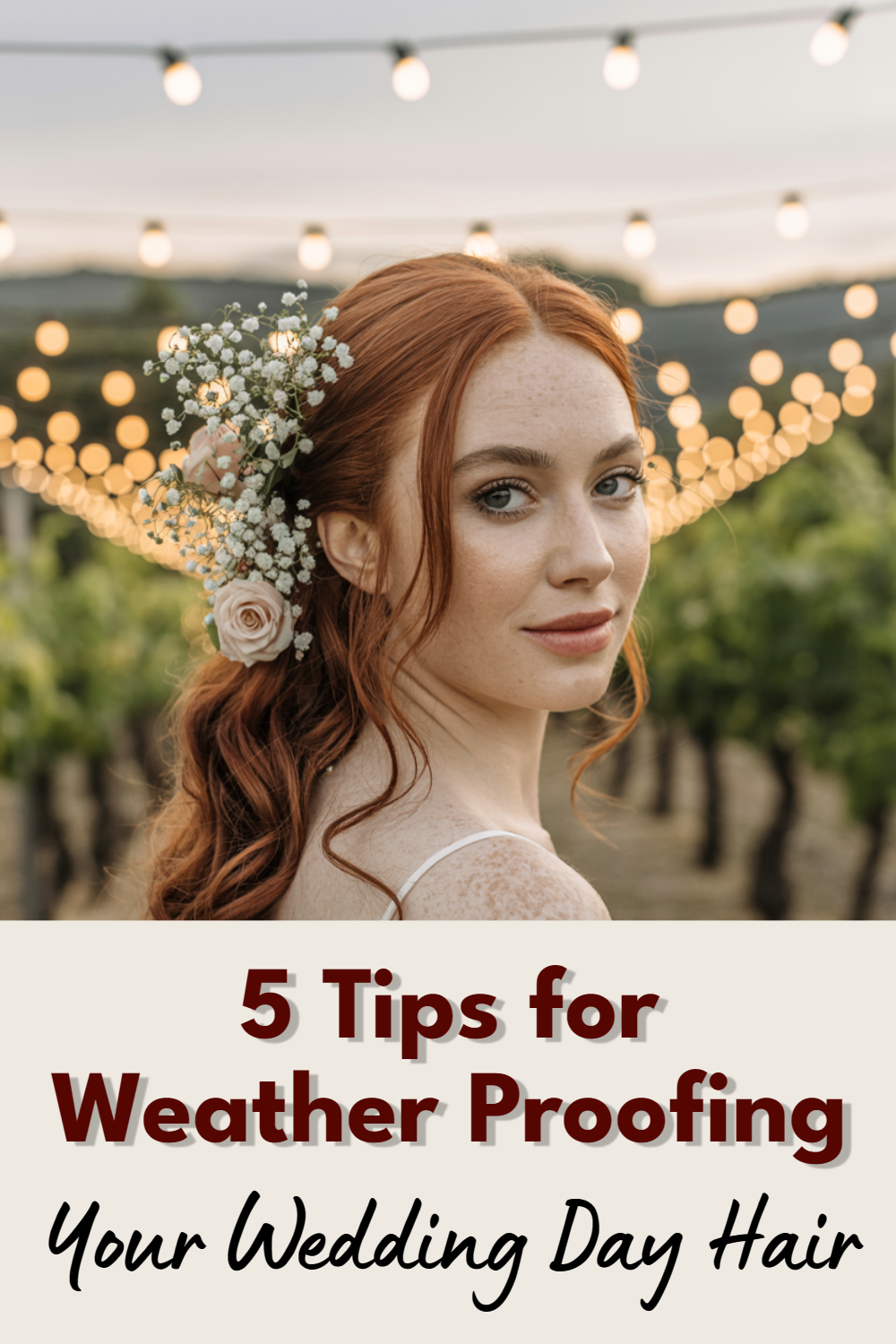Mother Nature doesn’t RSVP to weddings, but she shows up anyway.
After seeing countless brides battle humidity, wind, and surprise downpours, I’ve learned that the difference between wedding hair triumph and disaster often comes down to preparation and the right products.
1. Choose Your Base Wisely
Your hair’s foundation matters more than you think. Clean hair might seem like the obvious choice, but day-old hair actually holds styles better because natural oils provide grip and texture.
Wash your hair the night before your wedding, not the morning of. This gives your scalp time to produce just enough natural oils to help your style last without looking greasy.
Skip the Deep Conditioning Treatment
Save the intensive hair masks for your honeymoon prep. Deep conditioning treatments make hair too silky and slippery for pins and bobby pins to grip effectively.
A light leave-in conditioner on the mid-lengths and ends is all you need. Focus on protecting your hair without compromising the hold your stylist needs to create your look.
Embrace Texture Products
Sea salt spray becomes your best friend when weather threatens your wedding day. Spray it on damp hair before blow-drying to create grip and volume that lasts.
Texturizing powder at the roots gives your stylist something to work with. Even the most skilled professional struggles with hair that’s too clean and slippery.
2. Lock It Down with Professional-Grade Products
Drugstore hairspray won’t cut it when you’re facing eight hours of dancing, hugging, and potential weather drama. Professional products cost more upfront but save you from touch-up disasters later.
Your hairstylist should use a working spray during the styling process, not just at the end. This builds layers of hold throughout your style rather than relying on one final coat.
Invest in the Right Hairspray
Look for hairsprays labeled “humidity resistant” or “anti-humidity.” These formulas create a barrier against moisture that wants to wreak havoc on your curls.
Flexible hold sprays work better than maximum hold for wedding hair. You want your style to move naturally while maintaining its shape through all the emotion and activity.
Don’t Forget Heat Protection
Even if your ceremony is outdoors, your stylist will likely use hot tools during preparation. Heat protectant prevents damage and helps styles last longer.
Thermal protection sprays also add an extra layer of hold. Many contain polymers that activate with heat, creating stronger bonds in your hair structure.
3. Master the Art of Strategic Styling
Certain hairstyles naturally resist weather better than others. Updos generally outperform down styles when conditions get challenging, but the execution matters just as much as the choice.
Your stylist should create texture before forming the style. Smooth, sleek hair looks beautiful initially but falls apart faster when humidity or wind strikes.
Embrace Controlled Messiness
Perfectly smooth chignons show every flyaway and lost curl. Textured updos with intentional pieces and movement disguise minor weather-related changes.
Ask your stylist to pull a few face-framing pieces loose before securing them. This creates a romantic, effortless look that appears intentional even if other pieces come loose.
Consider Your Hair Type
Fine hair needs more product and tighter styling to survive weather challenges. Thick hair requires strategic placement of bobby pins and careful sectioning to prevent collapse.
Curly-haired brides should work with their natural texture rather than fighting it. Humidity will win the battle against straightened curly hair every single time.
4. Plan Your Timeline Around Weather Conditions
Timing your hair appointment strategically can make or break your weather-proofing efforts. Morning humidity levels differ from afternoon conditions, and your schedule should reflect this reality.
Book your hair appointment to finish at least 30 minutes before you need to leave for photos or ceremony. This buffer allows for final touch-ups and emergency fixes.
Check the Weather Forecast Obsessively
Start monitoring weather conditions a week before your wedding. Share updates with your hairstylist so they can adjust product choices and styling techniques accordingly.
Have backup plans for different scenarios. Outdoor ceremony hair might need to transform quickly for an indoor reception, and your stylist should know the game plan.
Create a Touch-Up Kit
Your hairstylist should provide a touch-up kit with the exact products used in your style. This isn’t the time for generic alternatives that might react differently with your existing style.
Include bobby pins that match your hair color, a small brush for smoothing, and the specific hairspray used. Assign someone reliable to carry this kit and know how to use it.
5. Protect Your Investment with Smart Accessories
Hair accessories aren’t just decorative—they’re functional armor against weather damage. Veils, headbands, and clips can actually help hold your style in place while adding beauty.
Choose accessories that complement your style’s structure rather than fighting against it. A delicate vine that follows your updo’s shape provides more support than a rigid tiara that sits independently.
Use Your Veil Strategically
Cathedral veils can shield your hair from wind during outdoor ceremonies. The weight and coverage provide surprising protection for intricate styles.
Remove your veil strategically for reception dancing. Many brides keep cathedral veils on too long, creating unnecessary stress on their hair and pins.
Consider Weather-Appropriate Alternatives
Flower crowns work beautifully in humid conditions because they embrace natural texture. Fresh flowers actually benefit from a bit of moisture in the air.
Headbands and hair wraps can save styles that start to fall. Choose accessories that can be added later in the day without completely redoing your look.
Emergency Protocols and Realistic Expectations
Even with perfect preparation, weather can still impact your wedding day hair. Having realistic expectations and emergency protocols prevents minor issues from becoming major meltdowns.
Designate someone other than yourself to monitor your hair throughout the day. You’ll be too busy and emotional to notice small problems before they become big ones.
Document your hair from multiple angles right after styling. These photos help your designated hair helper know what the style should look like for touch-ups.
Quick Fix Techniques
Bobby pins can solve most weather-related hair emergencies. Your helper should know how to twist loose pieces and secure them without destroying the overall style.
Hairspray touchups work best when applied to damp hands first, then smoothed over flyaways. Direct application often creates crunchy, obvious patches.
When to Accept Imperfection
Some weather conditions will impact your hair regardless of preparation. Accepting this reality reduces stress and helps you focus on enjoying your celebration.
Perfect hair matters less than perfect memories. Your guests won’t remember every flyaway, but they’ll remember your joy and confidence.
Final Thoughts on Wedding Day Hair Success
Weather-proofing your wedding day hair isn’t about achieving perfection—it’s about creating a style that can evolve gracefully throughout your celebration. The best wedding hair survives real life while keeping you feeling confident and beautiful.
Trust your preparation, trust your products, and trust that your love story matters more than every strand being perfectly in place.
After all, the most radiant brides are the ones who dance with abandon, hug with enthusiasm, and celebrate without worrying about their hair.


